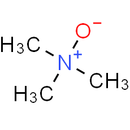Description
Trimethylamine N-oxide is a gut microbe-dependent metabolite of dietary choline and other trimethylamine-containing nutrients. Trimethylamine N-oxide induces inflammation by activating the ROS/NLRP3 inflammasome. Trimethylamine N-oxide also accelerates fibroblast-myofibroblast differentiation and induces cardiac fibrosis by activating the TGF-β/smad2 signaling pathway.
Product information
CAS Number: 1184-78-7
Molecular Weight: 75.11
Formula: C3H9NO
Chemical Name: Trimethylamine N-oxide
Smiles: C[N+](C)(C)[O-]
InChiKey: UYPYRKYUKCHHIB-UHFFFAOYSA-N
InChi: InChI=1S/C3H9NO/c1-4(2,3)5/h1-3H3
Technical Data
Appearance: Solid Power.
Purity: ≥98% (or refer to the Certificate of Analysis)
Solubility: Soluble in DMSO
Shipping Condition: Shipped under ambient temperature as non-hazardous chemical or refer to Certificate of Analysis
Storage Condition: Dry, dark and -20 oC for 1 year or refer to the Certificate of Analysis.
Shelf Life: ≥12 months if stored properly.
Stock Solution Storage: 0 - 4 oC for 1 month or refer to the Certificate of Analysis.
Drug Formulation: To be determined.
HS Tariff Code: 382200
How to use
In Vitro:
The size and migration of fibroblasts are increased after Trimethylamine N-oxide (TMAO) treatment compared with non-treated fibroblasts in vitro. Trimethylamine N-oxide increases TGF-β receptor I expression, which promotes the phosphorylation of Smad2 and up-regulates the expression of α-SMA and collagen I. The ubiquitination of TGF-βRI is decreased in neonatal mouse fibroblasts after Trimethylamine N-oxide treatment. Trimethylamine N-oxide also inhibits the expression of smurf2. Trimethylamine N-oxide is frequently found in the tissues of a variety of marine organisms that protects against the adverse effects of temperature, salinity, high urea and hydrostatic pressure.
In Vivo:
Trimethylamine N-oxide (TMAO) contributes to cardiovascular diseases by promoting inflammatory responses. C57BL/6 mice are fed a normal diet, high-choline diet and/or 3-dimethyl-1-butanol (DMB) diet. The levels of Trimethylamine N-oxide and choline are increased in choline-fed mice. Left ventricular hypertrophy, pulmonary congestion, and diastolic dysfunction are markedly exacerbated in heart failure with preserved ejection fraction (HFpEF) mice fed high-choline diets compared with mice fed the control diet. Myocardial fibrosis and inflammation were markedly increased in HFpEF mice fed high-choline diets compared with animals fed the control diet.
References:
- Wei Shuai, et al. High-choline Diet Exacerbates Cardiac Dysfunction, Fibrosis, and Inflammation in a Mouse Model of Heart Failure With Preserved Ejection Fraction. J Card Fail. 2020 May 14;S1071-9164(19)31802-0.
- Wenlong Yang, et al. Gut Microbe-Derived Metabolite Trimethylamine N-oxide Accelerates Fibroblast-Myofibroblast Differentiation and Induces Cardiac Fibrosis. J Mol Cell Cardiol. 2019 Sep;134:119-130.
- Manuel T Velasquez, et al. Trimethylamine N-Oxide: The Good, the Bad and the Unknown. Toxins (Basel). 2016 Nov 8;8(11):326.
Products are for research use only. Not for human use.
Payment & Security
Your payment information is processed securely. We do not store credit card details nor have access to your credit card information.


